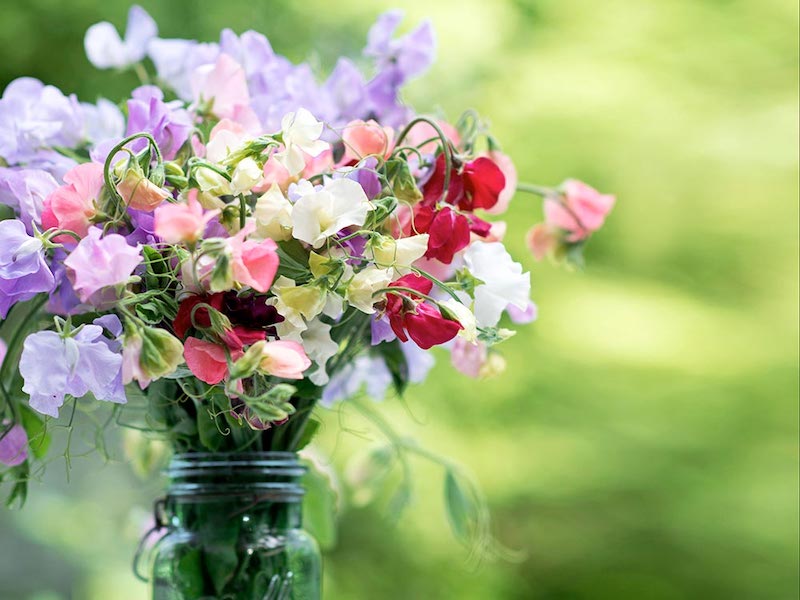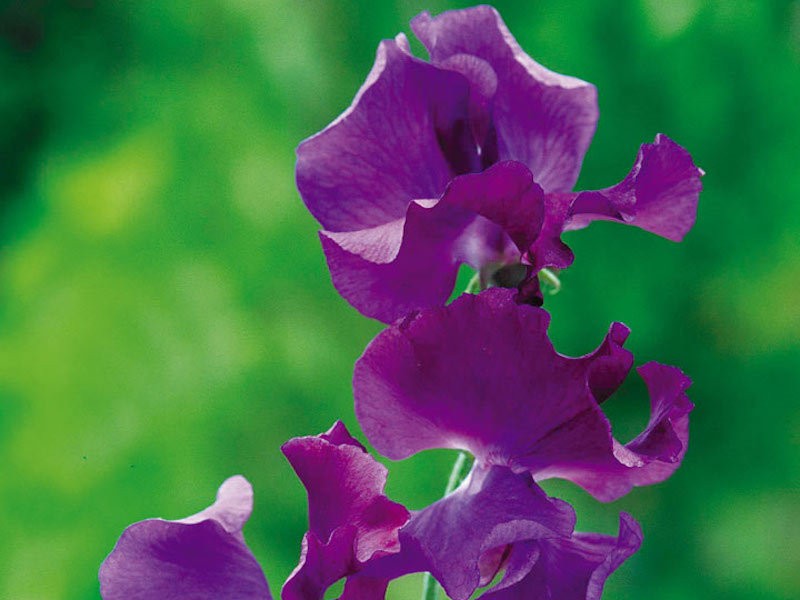It’s really easy to sow and grow sweet pea seeds, and there’s a wealth of good advice available online if you need help – including videos, articles and social posts produced by some of the most knowledgeable garden bloggers in the UK. Whether you’re looking for germination tips, help with the cordon method or just some fresh inspiration, here’s everything you need to know about growing sweet peas.
Contents:
- Best advice on how to grow sweet peas from seed
- Best advice on when to sow sweet peas – autumn or spring?
- Best advice on when to plant out sweet peas
- Best advice on the cordon method for growing sweet peas
Best advice on how to grow sweet peas from seed

Image: Sweet Pea Seeds – Sublime Scent Mix from Suttons (©Alamy Stock Photo)
Pre-sprouting your sweet pea seeds on damp kitchen roll in a special germination box is one of the many excellent tips from Debbie of @mrsbeesgarden. Once they’ve turned into little ‘tadpoles’, she gently pokes all 12 of her favourite varieties into pots ready to bloom next year. Scroll through her Insta photos to see the full lifecycle!
Elaine, one of The 3 Growbags sisters, celebrates the versatility of sweet peas and how simple they are to sow and grow – even for children – in her charming blog post: Lose yourself in plants. She sows her seeds as early as possible in root trainer pots indoors, but says you can even sow sweet pea seeds outdoors in warmer spring soils and still get good results.
If you’ve ever had problems getting your sweet pea seeds to germinate, Simon of Garden of Eaden has a generous little trick to share. Because the seeds of traditional varieties have a natural dormancy period, you need to nick the seed coat gently with a knife, rub it with sandpaper, or give the seeds a good soak. Check out his full post for more.
Lorraine from @lorris_twoplots has another nifty autumn-sowing trick to share. She says, “I keep the seeds in my freezer and sow straight from…[there] into deep 500g yogurt pots.” Not only do her sweet peas emerge within 10 days of sowing, they continue to grow throughout the winter in her unheated greenhouse, meaning she usually has flowers in May.
If you’re looking for sweet pea germination tips, Darren @thesweetpeaman has plenty of tried-and-tested advice. He explains that temperature is very important when it comes to success: “A constant minimum of 10C is required, in which it will take 10-14 days before you see signs of life, [and] the maximum temperature for successful germination is constant 20C.” Achieving almost 100% germination rates, Darren keeps his seed trays in an unheated room that’s about 18C. See his full post for more helpful tips.
Geoff, aka The Biking Gardener, acknowledges that sweet peas need a bit more attention than other hardy annuals in his straight-talking article: Starting sweet peas. He wouldn’t be without them in the garden, though, and explains his different methods, starting with sowing seeds in a cold greenhouse. Full of wonderful little nuggets of wisdom as well as interesting facts.
Best advice on when to sow sweet peas – autumn or spring?

Image: Sweet Pea Seeds – Prince of Orange from Suttons
Late March is optimum sweet pea sowing time for enthusiast Alison of The Blackberry Garden, who grows them every year. She says that although autumn sowings haven’t worked out for her, an experiment sowing sweet peas in late January was very successful. It could be worth a try. And you’ll love her trip down memory lane – all inspired by a vintage sweet pea seed packet!
Instagram gardener Katrina, at Homegrown Garden, discovered the joy of growing sweet peas a couple of years ago and now she’s hooked, as her self-portrait with a freshly picked bunch of white and burgundy blooms illustrates beautifully. She has sown in spring before but, because she likes her displays to start as early in summer as possible, she’s resolved to sow sweet pea seeds in autumn from now on.
There’s no mistaking Alan of Down to Earth’s preference in his post: Sow Sweet Peas in Autumn. You can’t say it clearer than that! A former nursery owner, he says you definitely get the best sweet peas from an autumn sowing, but adds that late winter and early spring are next best – the more the merrier!
“Last year I decided to sow sweet peas in the autumn and they were so much stronger in the spring,” says Hannah from @wildflowersofsussex. This professional florist is now a confirmed October sower, and definitely recommends starting them before winter sets in.
Whenever you decide to sow your seeds, if you want bushy plants that are smothered with flowers, don’t forget to pinch out the growing tips, says Tanya of Lovely Greens. Just one of Six Easy Tips for Growing Sweet Peas, she explains that you should “pinch out the top part of the plant just above the first set of leaves” as soon as your plants reach 4-6” tall. Then they will channel their energy into growing side shoots giving you double the number of blooms.
And if you run out of time or space, or have a problem germinating the seeds, don’t despair. The horticultural team at Suttons recommends ordering sweet pea plants ready to harden off and plant out in the spring. Don’t miss out on filling your home and garden with these joyful, fragrant blooms just because a mouse got into your greenhouse or you missed the sowing window! They even suggest ideas for new varieties to try.
Best advice on how to plant out sweet peas

Image: Sweet Pea ‘Sweetie Mix’ from Suttons (©Branded Garden Products)
Tips for preparing the ground and practical advice on how to plant out your sweet peas is simply and brilliantly explained in this short video by Carol of The Sunday Gardener. Weather permitting, Carol gets hers out in April. Because they’re vulnerable to slugs when first planted out, she recommends using organic slug pellets just to help get them off to a strong start.
Unless they’re tied or tumbling, sweet peas naturally look for something to cling to. Debbie from @mrsbeesgarden makes her own genius supports using plastic tubing and bamboo canes. Painted in black to striking effect, her homemade sweet pea frames are structurally interesting in their own right and help to get her plants off to a flying start. Scroll her images to see how they work.
If you have limited space in the garden, flowering sweet peas look fantastic tumbling out of hanging baskets. Claire of Claire’s Allotment shows us how to achieve this in her no-nonsense, easy-to-follow video: Potting Out Sweet Peas. Claire hangs her sweet pea baskets by the back door to provide a waft of glorious scent each time she steps out. What a lovely idea!
Over at @emmasallotmentdiaries, Emma also has a fantastic suggestion for planting out sweet peas. She’s created a fun sweet pea teepee which will eventually grow into a “floral covered hideout”. If you haven’t made one before, scroll through her images to see how it turns out!
Best advice on the cordon method for growing sweet peas

Image: Sweet Pea mix – Fragrant Skies from Suttons
The aim of growing your sweet peas by the cordon method is to achieve blooms with long straight stems for optimum flower arranging or showing potential. It can be labour intensive, but it’s all about quality over quantity.
If you want a sweet pea crop specifically for cutting and sitting nicely in a vase, look no further than Tea Break Gardener Katharine’s article on Growing sweet peas as cut flowers. Here you’ll find very detailed, beautifully illustrated instructions for creating a simple and effective cordon system. Having decided that 50 canes would be expensive to buy and difficult to store, Katharine’s clever step-by-step guide shows you how to use vertical strings to keep the cost down.
In an excellent video from Angela’s Kitchen Garden, host Angela shows you very clearly How to grow sweet peas with the cordon method – with close-up shots of exactly what to do. She reminds us of the importance of regularly snipping off the sweet pea plant tendrils to stop them wrapping around and damaging the flowers or twisting the stems as they climb up the canes.
“Cordon grown sweet pea plants need to be regularly tended to, at least once a week as a minimum, although twice a week, or more, would be preferable,” says horticulturist Beth over at the popular Pumpkin Beth blog. Regularly removing the tendrils prevents the plant from supporting itself, so she recommends reusable sweet pea rings to support the stems. She takes her sweet pea growing very seriously and her exceptionally thorough sweet pea growing trials explore the optimum time to sow your seeds, different growing methods, the best varieties, and how to produce the most blooms and the longest flower stems.
There are more great tips in the Cotswold Posy Patch post Sweet peas – the cordon method. Liz and Laura grow their sweet peas in a polytunnel, using rows of 10ft canes to produce stunning, straight-stemmed sweet peas. When they reach the top of the cane, Liz lays the stem along the ground before training it up another one, five canes along. Take a look at the amazing photos of this intriguing method.
With all this excellent advice to follow there’s no reason why you can’t have a bumper crop of beautiful and fragrant sweet peas adorning your plot, scrambling over archways, climbing up frames, brightening up the patio and cascading from hanging baskets. What a wonderful thought!
Lead image: Sweet Pea Seeds – Spencer Special Mix from Suttons (Image copyright: Floramedia)
See expert contributors here
Last Updated on February 10, 2025 by Suttons Horticultural Team





